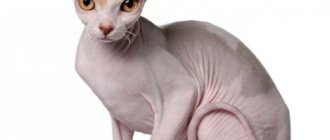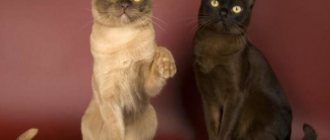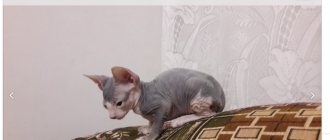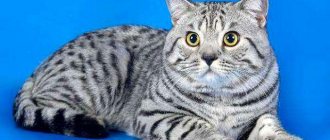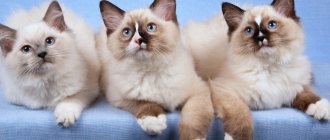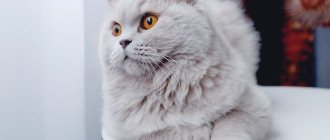For a long time, no one paid any attention to the ring-tailed cats living in the city of Fremont in California. Until, in 1998, the American Susan Manley began work to consolidate the “ring-tailed” gene among cats. Susan initially named cats with this distinctive feature Ringtailed Sing-a-Ling, but the breed was later renamed the American Ringtail in 2004, and in 2005 the breed was given experimental status. At the moment, the ring-tailed cat breed is not yet recognized by any of the major associations of felinologists, but it is attracting increasing attention from connoisseurs of unusual cats; it has become widespread in Canada. DescriptionCharacterCareFoodCost
Description of the breed
The American Ringtail is a young cat breed that appeared only 10 years ago. Its highlight is the tail, twisted into a ring and lying on the back. This, at first glance, “inconvenient” feature should cause discomfort, but this is an absolutely natural position of the tail, due to the flexibility of the vertebrae.
Ringtails come in shorthair and semi-longhair. Which one to choose is a matter of taste. This nuance will not affect the complexity of care.
This breed is perfect for living in a large family. They are friendly and inquisitive, and also patient with children. Their only drawback is their excessive vocality. All their actions and emotions are accompanied by meowing. For people who love peace and quiet, a ringtail is not suitable.
History and breed standard
The American Ringtail breed is very young. Her story began in 1998, when an American woman named Susan Manley adopted a kitten with a curled tail. The lucky one was named Solomon. Outwardly, he was the most ordinary cat, if not for the unusual position of his tail.
When Solomon had his first offspring, it turned out that the “ring-tailed” gene was passed on to some of the kittens born from him. Susan decided to study this phenomenon. It was subsequently discovered that ring-tailed cats are found throughout California. Moreover, this phenomenon occurs in representatives of different breeds.
Having involved a group of felinologists, Susan begins breeding work. Very quickly they manage to achieve the fixation of the “ring-tailed” gene. Already in 2000, in one of the litters, all kittens were born with curled tails.
The original name was rejected and after much discussion it was decided to call the breed “American Ringtail”. For a long time the breed existed on its own, but in 2005 it was finally accepted for registration with TICA and given the status of “experimental”, which has not changed to this day. Unfortunately, not a single serious association has recognized it yet, but this does not at all prevent ringtails from gaining popularity and costing up to $1,000.
Ringtail cat or American Ringtail
The ring-tailed cat breed, or American Ringtail, is very young and has not yet received official recognition. All that American breeders and their Canadian colleagues managed to do was assign the breed “experimental” status.
She appeared thanks to a stray kitten from California (who was later named Solomon). Solomon would have been a completely ordinary feline, if not for one circumstance - his tail was unusually long, and also curled over his back. He was sheltered and raised by Susan Manley, who was interested in such an interesting feature. She began to study this issue and, after consulting with experts, found out that cats with curled tails are found throughout California. Soon this information was confirmed: in the city of Fremont, 3 more cats (of different breeds - Maine Coon, Munchkin, Scottish Fold) with exactly the same tails were discovered. And the kittens born from the matured Solomon inherited this “father’s” feature. At this time - since 1998 - Susan Manley came up with the idea of doing breeding work - with the goal of securing the “ring-tailed” gene, or, to put it more simply, breeding ring-tailed cats. Following a special program, in 2000 she was able to achieve a litter in which all the kittens were owners of the ring-tailed gene, and in 2005, ring-tailed cats were crossed with the Ragdoll breed. The result was a semi-longhaired variation. Soon the unusual breed began to enjoy increased interest throughout the country. The name of the breed is connected - as is already clear - with the main feature of its representatives: a long and muscular tail that extends onto the back, where it bends almost into a closed ring. This unusual structure is the result of the action of two genes. One of them - the dominant one - is responsible for the “airiness” of the tail, that is, its vertical elevation. While the second (recessive), in fact, “twists” it into a ring. At the same time, cats do not experience any particular inconvenience (due to the fact that there are no fused vertebrae) and use it freely. Towards the end the tail becomes narrower, at the base, on the contrary, it widens. A spirally twisted tail is considered an unacceptable fault of the breed. The typical ringtail is a medium-sized cat with a muscular, slightly elongated body and a small head. The length of the limbs is average, the paws are oval. The hind legs are shorter than the front ones, however, outwardly such a disproportion is invisible. Moreover, this body structure allows cats to climb trees well and perform various maneuvers. The muzzle of the ring-tailed cat is rounded, the chin and whisker pads are clearly visible on it. The ears are of medium length, wider at the base; the tips are rounded. The eyes are wide and almond-shaped. Their color can be any, since this feature is not regulated in any way by the standard. Ring cats can be shorthaired or semi-longhaired. In the first case, the hair is short, elastic, and looks like plush fabric. The undercoat is medium. The second variety has medium-length hairs and a poorly developed undercoat. Representatives of this breed are perfect for family people. Ringtails have a calm and friendly character. They are moderately playful, but very curious, so they can explore unfamiliar things, terrain, and people for a very long time. As a rule, a cat bonds with only one family member. She perceives others calmly, but does not show indifference; gets along well with children; with other pets. The ring-tailed cat is a “talkative” breed, so it is unlikely to suit those who love peace and quiet. Ringtails can, in principle, tolerate loneliness (not for too long) calmly, but a long separation from the owner will be stressful for him. Another interesting feature is the set of “wild” habits inherent in this breed. So, ring-tailed cats are big fans of climbing trees, shelves, cabinets and other high furnishings. They also like to drink from the tap and play with water, hunt rodents, and hide leftover food. In a house where a cat of this breed lives, there must be:
• scratching post; • house for sleeping; • lots of toys; • climbing structures – a pole or other similar object.
Caring for a ringtail is not difficult and does not require much time. Once a week you should examine your pet, clean its ears and teeth, comb it and check it for parasites. It is recommended to bathe your ringtail once a month. Grooming involves purchasing a rare comb, a slicker brush and a furminator. For cats with short hair, you also need a rubber mitten. Ringtails have a very good appetite, so you need to carefully monitor their weight. Extra pounds (especially in old age) can cause various diseases. However, your pet should always have dry food in a bowl. But the amount of canned food should be limited: give only as much as the cat can eat in one meal. Hereditary diseases have not yet been identified in ring-tailed cats. However, too little time has passed to state with certainty their absence. The average life expectancy of the breed is from 11 to 16 years. The cost of a kitten is quite high - from $1000. This is explained by the fact that in our country there are no specialized nurseries for breeding American ringtails. Anyone wishing to purchase a ring-tailed kitten can do so only through North American or Canadian nurseries.
External signs
The American Ringtail is a medium-sized cat of the semi-eastern type. She has a strong, athletic body with well-developed muscles and flexibility. The overall exterior creates a certain balance between muscularity and strength and at the same time refinement of lines. Stocky and short specimens are not acceptable by the standard.
The ring-tailed cat's head is shaped like a modified wedge with a sculpted muzzle. She has well developed whisker pads and chin. My eyes are almond-shaped and slightly slanted. The ears are medium sized and set wide apart.
The cat's tail is long, elastic, wide at the base, tapering towards the end. Ideally, he should practically wrap himself in a ring and lie on his back. It is strictly unacceptable to twist the tail into a spiral. This is a serious defect. By the way, the peculiarity of the position of the tail does not affect its functionality in any way. He is very flexible and mobile.
The standard does not regulate coat color or eye shade. It can be absolutely anything. Short-haired representatives of the breed have a soft and plush coat. But cats with semi-long hair have thin and silky hair, with virtually no undercoat.
Historical information
The breed's existence dates back to 1999. In Northern California (USA), Susan Manley picked up a small kitten on the street, brought him home and named him Solomon. When the pet began to run around the apartment, the owner noticed his unusual tail. After a few months, the process curled into a ring. Susan decided to show the kitten to felinologists and breeders, and later a whole family of similar animals was discovered in her area.
Manly worked with Solomon for five long years. She tried to prove that the gene for a ring-shaped tail is inherited. Several famous specialists helped her. At first, the breed was named Ringtail Sing-a-Ling in honor of its owner's favorite book. The breeding program began in 1999, with the first litter producing kittens with different tails. But Susan was trying to achieve something else.
After a suitable pet was born, the breed was renamed the American Ringtail. But the first nursery was named “Singaling”. In 2004, the breed was allowed to be registered at exhibitions, but participation in them was still prohibited.
A year later, long-haired pets appeared, which were bred by crossing with ragdolls. Even today, it is very difficult to get a purebred ring-tailed cat; several catteries are located only in the USA and Canada.
Character
The Ringtail is a friendly and sociable breed. These cats easily make contact and quickly get used to their owner. Despite the fact that in most cases a cat chooses only one owner, she also behaves affectionately and friendly with the rest of the family. There is no need to be afraid of bringing a ringtail into a family with children, as this breed is completely non-aggressive. They easily make friends with children and sometimes show remarkable patience with them.
Ring-tailed cats get along well with other pets in the house. They are not prone to conflicts and behave on equal terms with other animals.
Character and behavior
These animals have a wonderful character. They are affectionate, tame, do not require much attention to themselves - they are unpretentious and independent. They are friendly and will never show aggression towards other animals and children. They can be both active and calm, but their curiosity cannot be taken away from them: they study everything new with interest. They love to climb somewhere higher and walk on top of cabinets. At the dacha, every tree is examined and hunting trophies - mice and rats - are brought to the owner’s feet. He actively shows interest in bodies of water, and in the apartment – in the taps in the kitchen and bathroom. Your pet will create secret places for itself, its own “warehouse” under the bed and will replenish it. It is not recommended to leave your pet alone for a long time.
Maintenance, care, health
Caring for long-haired and short-haired ringtails is slightly different, but in both cases it is not difficult. To care for short-haired representatives of the breed, you need to purchase a rubber massage mitten. You can brush your cat with a regular brush. Long-haired ringtails also do not need frequent brushing, but they need a more serious comb.
It is recommended to bathe a cat of this breed no more than once a month. Their skin is not prone to allergic reactions and dryness, so any cat shampoo will do.
The breed is still young, but over the 15 years of its existence, no genetic diseases have been identified in cats. They are in good health, and their average age is 15 years.
Ring-tailed cats love to sharpen their claws, so they need to be taught to use a scratching post from early childhood. If necessary, nails should be trimmed once every 2-3 weeks.





